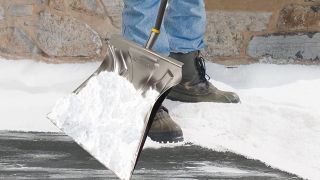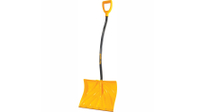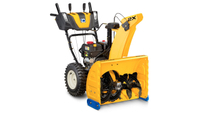The absolute best way to clear snow from your property is to get someone else to do it. This method is fool-proof, assuming the other person involved actually turns up to do the job, and a handy neighbour or their teenage son armed with a stout shovel or powered blower can make all the difference. All joking aside, this is how it’s done. Clearing a path from your door to the driver’s side of your vehicle is the first thing you should do, rather than walking all over the snow and compressing it with your footprints. Making sure your car or truck is prepared for the winter weather is essential too. Start it before you begin shovelling in earnest, and it will be defrosted by the time you finish. It’s best to be prepared for snow too, keeping removal options at hand rather than having to walk in deep drifts to an outbuilding to collect them even before you begin clearing. It’s also a good idea to have a plan before you begin, as high winds and a runny nose can scupper your ability to think clearly. Shovels are the cheapest option, the traditional large-bladed plastic or aluminum type able to clear a surprising amount of the powdery white stuff while being light and easy to store. We have a guide to the best snow shovels (opens in new tab) for you to browse. A wider, two-handed snow scoop can move even more, and there are push shovels too that move the snow to the side rather than picking it up and dumping it in a pile. A shovel with wheels may make sense if you need to move a lot of snow, as it simplifies the process and can speed you along. Smaller, collapsible shovels are really meant for storing in your car if it’s likely you’ll be snowed in while out driving. Proper technique is essential while using a snow shovel, and it’s worth doing some stretches first too - you’ll be working in a cold environment while encumbered by heavy boots and gloves, so a warmup is required. Remember not to lift with your back, bend your knees instead, and switch between lifting with your right and left hands periodically to decrease the strain put on any one group of muscles. Don’t try to remove more than six inches of depth at once, instead skim the top off and come back to finish the rest. You should also be aware that overexerting yourself can be very dangerous. Shovelling snow is far harder than you might think, and you’re doing it in the cold, when your arteries are more constricted, putting you more at risk of a heart attack. This article (opens in new tab) from the Cleveland Clinic is an essential read if you’re worried about your heart health, and need to shovel snow. Make sure you know where you’re going to drop or push the snow, as you don’t want to be moving the same snow twice - putting it in front of a door or path just means more work. And try not to create large piles, as the tops can fall down over the area you’ve cleared. If you have plants alongside your driveway, try to avoid burying them too deeply so sunlight can still penetrate and the weight doesn’t push down on them too much. If the street outside is regularly plowed, beware the snow that’s thrown up from it - it can be heavy with salt from gritting, and many plants cannot tolerate this. If you have a particularly large area to clear, or you have difficulty handling a shovel, then it can make sense to buy a powered snow blower. Again, we have a guide to the best snow blowers (opens in new tab) for your reference. There are both gas and electric models, with the latter being more convenient, lighter, and smaller, but coming with the caveat that you need to trail a cord behind you. Owners of long driveways are going to want a gas-powered blower, which must be properly stored and maintained along with its fuel supply. Check it earlier in the season to make sure it starts first time. Using a snow blower is similar to a shovel, especially if you’re using a heavier model. Be sure not to strain yourself, and ensure that the piles of snow you create aren’t going to inconvenience you further along the line. Snow blowing is less accurate than shovelling, so you may need to designate larger areas for your piles. You’ll still need a shovel to get into some smaller areas that you can’t clear with the blower, but when clearing a large area the blower will be faster and less strenuous. If you have other debris in your yard, it may be advisable to clear it with a good chainsaw (opens in new tab), as you may accidentally jam up a snow blower with loose branches. Blowers are, however, considerably more expensive than a shovel, so evaluate how much snow you get, to what depth and how frequently, before you make the investment.


